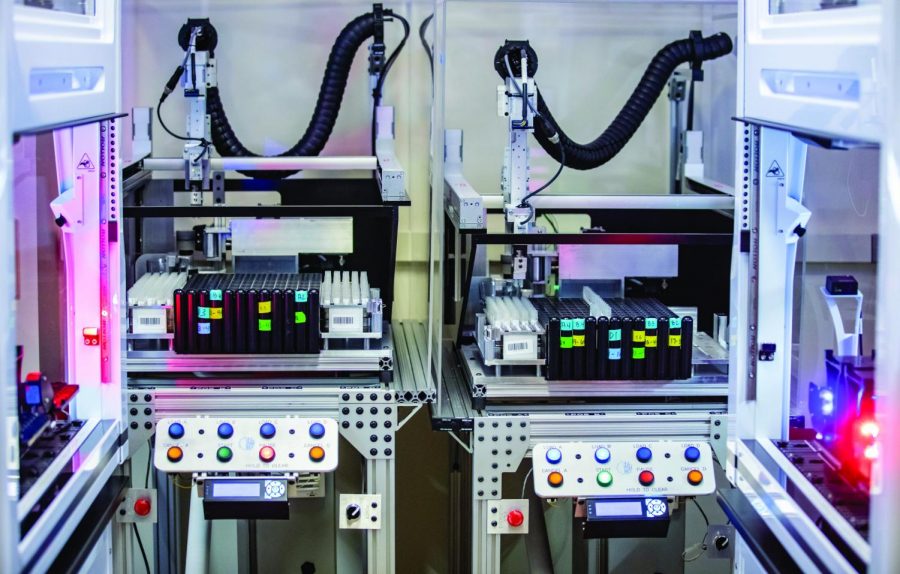UI advances spring tests through automation
Photo Courtesy of Veterinary Diagnostic Laboratory
A robot processes COVID-19 saliva tests in the Veterinary Diagnostic Laboratory. The lab has delivered an average of 10,000 test results per day between Jan. 21 and Jan. 29.
February 4, 2021
The Veterinary Diagnostic Laboratory is shifting toward a more automated approach to processing COVID-19 saliva tests with the usage of four robots to enhance the test.
The lab has processed 1,231,143 saliva samples of COVID-19 as of Jan. 31, delivering an average of 10,000 test results per day from Jan. 21 to Jan. 29.
Dr. Timothy Fan, member of the SHIELD team and professor of veterinary clinical medicine, said that this semester will be heavily robotic as the team looks for a “hybrid sweet spot” or balance of automation and manual handling of samples.
Two decapping robots invented by TEKMILL, a contract design and fabrication business located in the University of Illinois at Research Park, and two liquid handling robots purchased separately, have been extremely successful in “increasing the fluidity of tests” and also heavily increased the automation of the processing samples.
Fan says that the team “didn’t really begin to transition heavily into using the decapping robots until the past few months.” This change was in part sparked by inspiration from the Broad Institute of MIT and Harvard, a research hub.
Get The Daily Illini in your inbox!
According to Fan, a video shown by the institute which displayed a lot of robotics in their COVID-19 test processing system inspired the members of the team to move toward automating processes at the Veterinary Diagnostic Laboratory.
David Doub, lab technician at the Veterinary Diagnostic Laboratory, explained the process in which the lab’s decapping robot lifts and decaps a tube before it places a barcode on the tube so that the liquid handling robot is able to read the barcode and place part of the sample into a 96-well plate.
The plate then gets loaded into a PCR machine. Doub said that the increase of automation, specifically the University created decapping robots, saves technicians time, space and from a repetitive stress injury that could be a result of frequent manual decapping.
“To decap with a human is a very manual process, and you can get a repetitive stress injury if you’re doing too much of it manually,” Doub said.
The decapping robot created by TEKMILL was tweaked a few times in order to further enhance the testing process. According to Fan, it was tweaked to take a more efficient path of decapping than it was originally created to take.
Fan says that they are hoping to move towards “70, 80, maybe 90 percent of our samples being handled with this more automated system” in order to alleviate pressure from lab technicians, allow them to reallocate their time and decrease the amount of labor they have to do.
He said steps of the process will always remain manual because of the need for “some human component” in order to visually inspect that sample and manually transfer the saliva. The team is pleased with the increased automation.
“We’re looking very much forward to automation to complement and facilitate the processes we’ve used since last semester,” Fan said.







